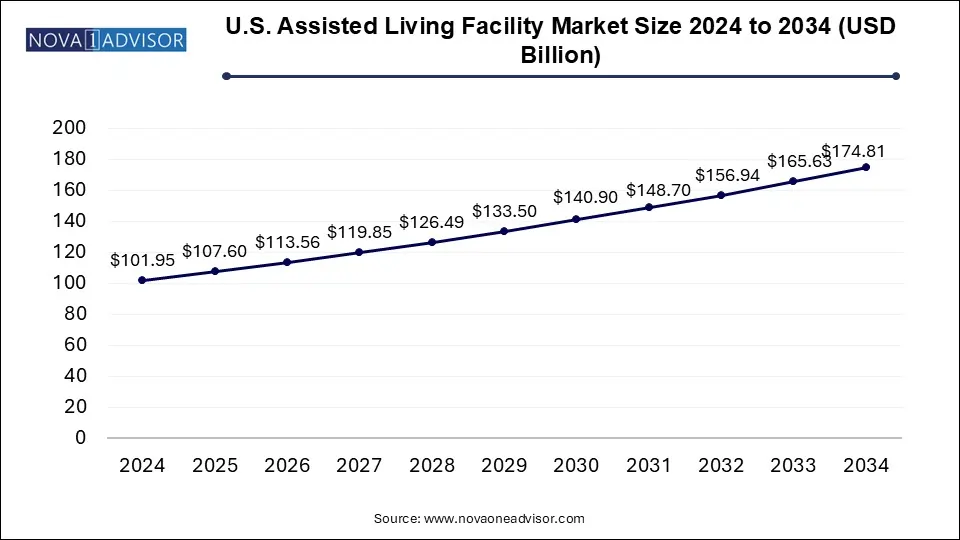The U.S. assisted living facility market size was exhibited at USD 101.95 billion in 2024 and is projected to hit around USD 174.81 billion by 2034, growing at a CAGR of 5.54% during the forecast period 2025 to 2034.

| Report Coverage | Details |
| Market Size in 2025 | USD 107.60 Billion |
| Market Size by 2034 | USD 174.81 Billion |
| Growth Rate From 2025 to 2034 | CAGR of 5.54% |
| Base Year | 2024 |
| Forecast Period | 2025-2034 |
| Segments Covered | Age, Region |
| Market Analysis (Terms Used) | Value (US$ Million/Billion) or (Volume/Units) |
| Regional scope | West; South; Midwest; Northeast |
| Key Companies Profiled | Kindred Healthcare, LLC; Brookdale Senior Living Inc.; Sunrise Senior Living, LLC; Atria Senior Living, Inc.; Five Star Senior Living; Capital Senior Living; Merrill Gardens; Integral Senior Living (ISL); Belmont Village, L.P.; Gardant Management Solutions |
Major factor driving the market growth is the growing geriatric population seeking companionship, security, and assistance with daily activities, are residing in ALFs. The rise in the geriatric population due to increased life expectancy is expected to grow rapidly in the future. According to National Institute on Aging (NIA), globally, around 8.5% of the population is aged 65 and above. As per data published by Population Reference Bureau, the number of Americans aged 65 years & above is projected to reach 95 million by 2060, from 52 million in 2018.
The rise in the geriatric population due to increased life expectancy is expected to grow rapidly in the future. According to National Institute on Aging (NIA), globally, around 8.5% of the population is aged 65 and above. As per data published by Population Reference Bureau, the number of Americans aged 65 years & above is projected to reach 95 million by 2060, from 52 million in 2018.
Technological developments for ALFs are expected to propel its U.S. market. The development of sophisticated & easy-to-use devices and services, such as Internet-enabled home monitors, telemedicine, and apps for mobile health, is likely to boost the market over the forecast period.
Over the past few years, the healthcare sector has witnessed various technological advancements, such as wireless data communication, electronic health records, telemedicine/telehealth, activity monitoring systems, fall prevention or detection systems, tracking or wandering management systems, and medication adherence systems. For instance, an electronic medication adherence system enables tracking a patient’s medication schedule and whether they are following it.
Based on the nature of the population served and service provision, residents at assisted living facilities may be at a high risk of contracting COVID-19. According to the CDC, in the early months of the pandemic, around 2.1 million people lived in residential care or ALFs and nursing homes, which represents 0.6% of the U.S. population. A number of these facilities became hotspots for the transmission of the novel coronavirus and 42% of the total COVID-19 deaths in the U.S. were ALF residents.
An increase in the baby boomer population, rising incidence of brain injury, growing prevalence of target diseases, and technological advancements are major factors contributing to the growth of the market. More than 85 years segment accounted for the largest market share of 52.35% in 2024 and is expected to register the fastest CAGR of 5.65% during the forecast period, while the 75 to 84 age group was the second largest segment in 2024.
In the U.S., the growing geriatric population is seeking ALF services to improve their quality of life. According to the United States Census Bureau, the 75 to 84 age group made up roughly 14.3 million or 29% of the senior population in 2016, which is more than double the number and proportion (6.3 million or 13 percent) of those 85 & older. Around 27% of the population is between the ages of 75 and 84.
According to data published by Aging.com, two million housing facilities will be needed for senior residents for adequate living space by 2040. The concept of continual care retirement communities is gaining traction among seniors with high disposable income. Such retirement communities are known to cater to people aged 50 years and above. The idea behind these communities is to prevent seniors from relocating when additional care is needed. As a result, the less than 65 years segment is likely to receive a moderate boost over the forecast period.
On the basis of region, the market is categorized into West, South, Midwest, and Northeast. The west region dominated the segment with the largest market share of 41.38% in 2024, which can be attributed to the presence of the highest number of ALFs in the region. The South is expected to witness the fastest growth owing to the increasing geriatric population and rising demand for senior care facilities.
ALFs in the South are evenly distributed among small, medium, and large facilities. Some of the largest senior care organizations, such as Brookdale Senior Living, Inc. and Sunrise Senior Living, Inc. are located in the South. The south region is estimated to register the fastest CAGR of 6.20% from 2025 to 2034. Texas is one of the fastest-growing states in terms of improved living conditions and a number of facilities for senior residents. However, ALFs in certain states of the Southern region are facing a shortage of healthcare workers.
This report forecasts revenue growth at country levels and provides an analysis of the latest industry trends in each of the sub-segments from 2021 to 2034. For this study, Nova one advisor, Inc. has segmented the U.S. assisted living facility market
By Age
By Region